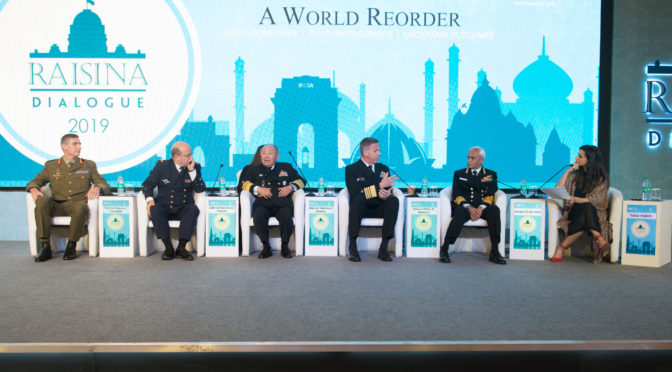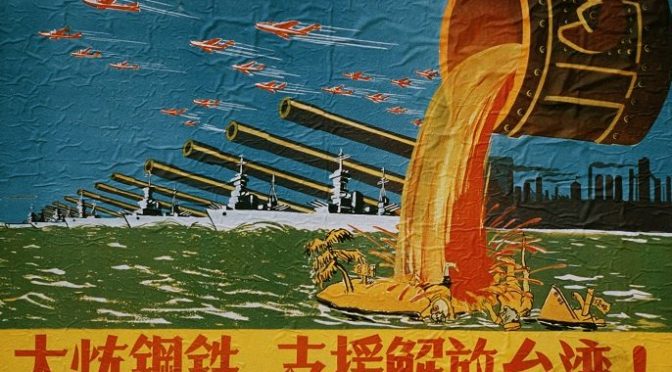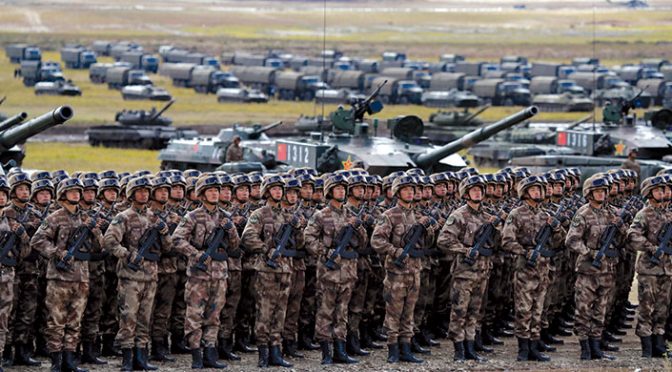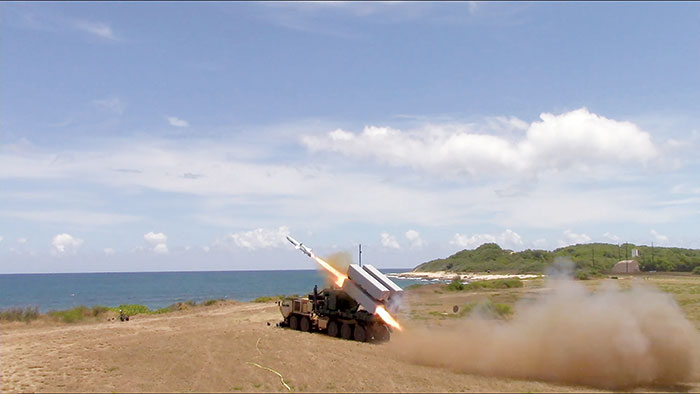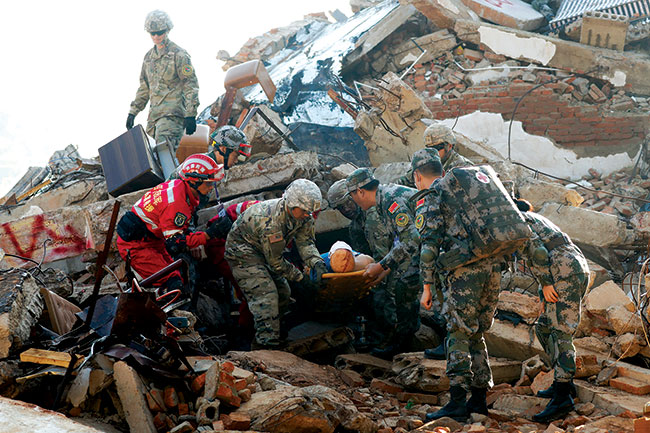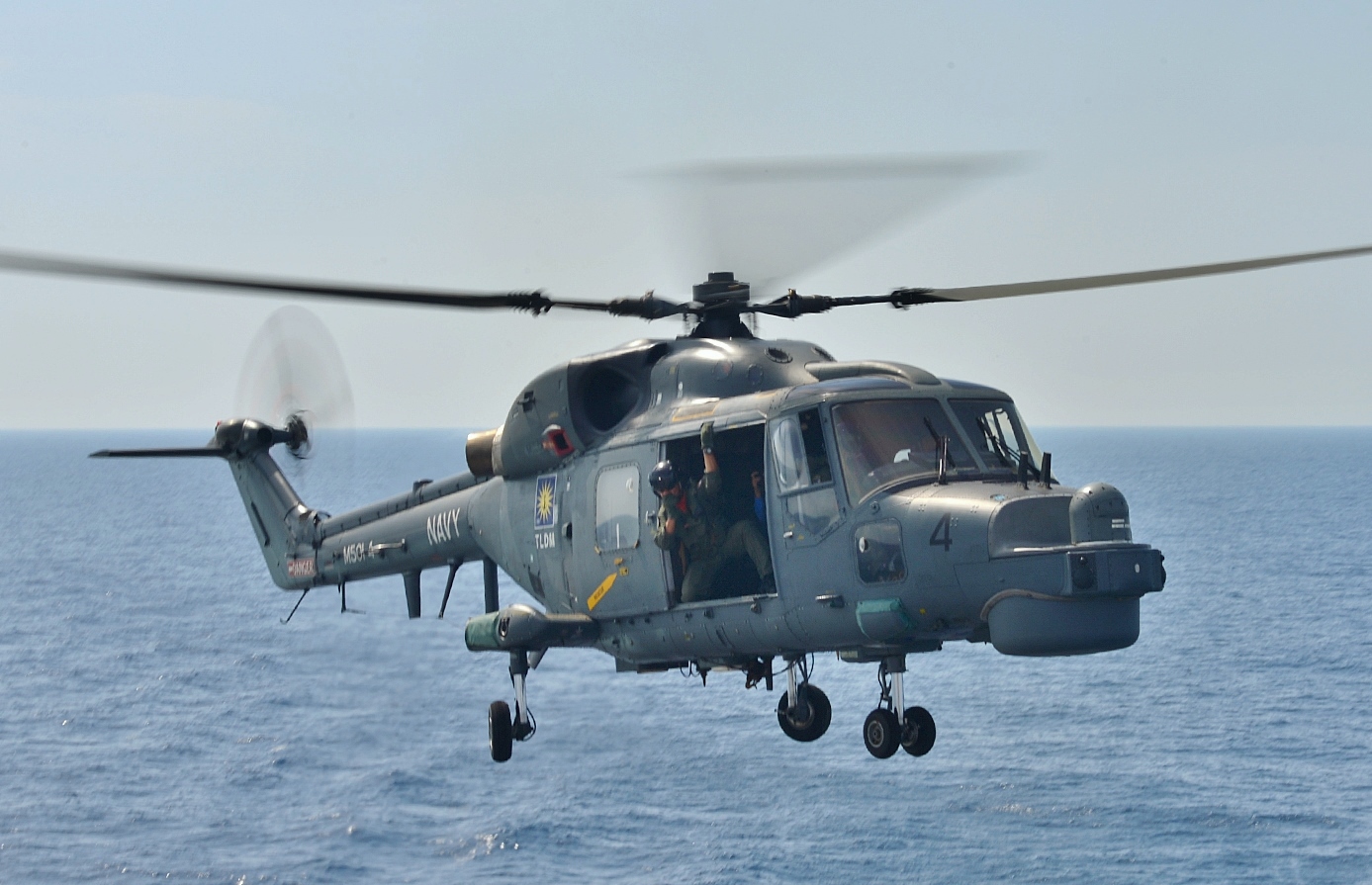By David Scott
The annual Raisina Dialogue, hosted by India since 2016, is useful for highlighting the process of maritime strategic convergence between Australia, France, India, Japan, the U.K., and the U.S. The Raisina Dialogue was initially set up by India as a high-level forum for international discussion. Tellingly, Chinese officials have never been invited. For the last three years, from 2018 to 2020, there were panels specifically dealing with the Indo-Pacific that brought together naval leaders from various China-concerned countries. This built on the 2016 and 2017 iterations which brought keynote speeches and warnings from the U.S. naval leadership, alongside a maritime focus from Japan, India, and the U.K. What follows is a review of each year of the Raisina Dialogues, with a focus on the growing scope of collaboration between nations increasingly concerned about China’s Indo-Pacific push.
2016: Opening Talks
This was the first Raisina Dialogue, held from 1–3 March, with a focus on Asian connectivity. One of the participants was Admiral Harry Harris, chief of U.S. Pacific Command (PACOM), complete with his emphasis that:
“The United States is conducting our strategic Rebalance west to the Indo-Asia-Pacific. You need look no further than last October’s Malabar maritime exercise between India, Japan and the United States to see the security inter-connectedness of the Indian Ocean, Asia, and the Pacific Ocean regions.”
It was significant that he highlighted the strategic unity of both oceans, that he pinpointed America’s own transfer of resources across to the Indo-Pacific, and that he further pinpointed the emergent trilateral maritime partnership between India, Japan, and the U.S. The Malabar exercises had been bilateral India-U.S. affairs since 1992, but Japan was invited as a permanent participant in the October 2015 iteration and thereafter.
Two contextual programs starting in 2015 were China’s creation of artificial islands in the South China Sea (running through the next few years), and PACOM’s initiation of Freedom of Navigation Operations (FONOPs) around such artificial militarized creations of China, the tempo of which have been increased since 2017 under the Trump administration.
2017: Marine Geography of the Indo-Pacific
In 2017, no specific maritime panel was held at the Raisina Dialogue held on 17–19 January. Nevertheless strong maritime messages were prominent. Prime Minister Modi’s formal address pinpointed that with India “being a maritime nation, in all directions, our maritime interests are strategic and significant”; for which “we believe that respecting freedom of navigation and adhering to international norms is essential for peace and economic growth in the larger and inter-linked marine geography of the Indo-Pacific.” India’s chief of the Western Naval Command Vice Admiral Girish Luthra in a panel on “Evolving Politics of the Asia-Pacific” noted that “the regional order in Indo-Pacific is in transition, particularly in East Asia,” with veiled comments about the “economic blandishments” posed by China’s Maritime Silk Route (MSR) propositions announced by President Xi Jinping in October 2016.
Japan’s Parliamentary Vice-Minister for Foreign Affairs Shunsuke Takei, pinpointed further maritime issues at the 2017 Raisina Dialogue:
“In recent years, we have been witnessing scenes of increasing tensions between States, in the seas of Asia… Absence of the rule of law means giving way to dominance by force. To ensure open and stable seas and freedom of navigation and overflight, Japan underscores the importance of the observation of international law, including United Nations Convention on the Law of the Sea (UNCLOS), which is the ‘constitution of the oceans.’ Concrete actions and cooperation based on such a universal law are needed.”
Concrete actions and concrete cooperation, particularly to uphold freedom of navigation, was aimed at China in the South China Sea, and was a call for essentially naval cooperation. The reiteration of the importance of UNCLOS was aimed at China’s rejection of the Permanent Court of Arbitration (PCA) ruling against it in various South China Sea UNCLOS issues in July 2016.
Finally, Admiral Harry Harris, PACOM chief, in a keynote speech welcomed the developing maritime cooperation between India and the U.S, witnessed in the ever strengthening Malabar exercises. He looked forward to ongoing trilateral India-Japan-U.S. maritime cooperation. China was discernible in his analysis:
“No matter how many bases are built on artificial features in the South China Sea, I say this often but it’s worth repeating: we will cooperate where we can, and be ready to confront where we must… There are those who question the motives for the increasingly cooperative relationship between the U.S. and India. They say that it’s to balance against and contain China. That’s just simply not true. Our relationship stands on its own merits.”
The first point was a direct denunciation of China’s artificial islands created in the South China Sea (the “Great Wall of Sand”) process of pouring sand and concrete onto semi-submerged reefs and atolls, and their subsequent militarization of harbors, airstrips, and missile batteries. The second point was diplomatic to the point of masking. The U.S. and India had various shared interests (democracy, economics, anti-terrorism) but rising concern about China was one important factor in their strategic convergence, even if unstated.
The then-U.K. Foreign Secretary Boris Johnson was able to announce at the 2017 Raisina Dialogue that “we have just decided to restore our military presence east of Suez,” where “as our naval strength increases in the next ten years, including two new aircraft carriers, we will be able to make a bigger contribution,” including “in the Indian Ocean, we have a joint U.K.-U.S. facility on Diego Garcia – an asset that is vital for our operations in the region” and that “we oppose the militarisation of the South China Sea and we urge all parties to respect freedom of navigation and settle their disputes peacefully in accordance with international law.”
2018: Uncharted Waters: In Search of Order in the Indo-Pacific
The 2018 Raisina Dialogue, held on 14–16 January, witnessed new developments: (a) a formal Indo-Pacific panel titled “Uncharted Waters: In search of Order in the Indo-Pacific”; (b) made up of naval chiefs from the U.S. (PACOM chief, Admiral Harry Harris), India (Chief of Naval Staff, Admiral Sunil Lanba), Australia (Vice Admiral Tim Barrett, Chief of Navy), and Japan (Chief of Joint Staff, Admiral Katsutoshi Kawano). Harris, having given relatively muted warnings in 2016 and 2017 at the Raisina Dialogue, was more explicit at the 2018 Dialogue, arguing that “the reality is that China is a disruptive transitional force in the Indo-Pacific. They are the owners of trust deficit.” Kawano was equally pointed, that “China’s military power is becoming more powerful and is expanding. In the East and South China Seas, China has been ignoring international law. In order to deter Chinese provocations, India, the U.S., Australia and Japan have to cooperate with one another.” Lanba focused on Chinese appearance in the Indian Ocean, particularly at Djibouti and Sri Lanka. Chinese state media was dismissive of the process, with the Global Times (25 January) running articles headlined “New Delhi forum props up ‘Quad’ stance, refuses to listen to China voice.”
2019: Indo-Pacific – Ancient Waters and Emerging Geometries
The 2019 Raisina Dialogue, held from 8–10 January, reflected another twist on strategic geometries as France joined the Quad partners. Consequently, military leaders from Australia (General Angus Campbell, Chief of the Defence Force), France (Admiral Christophe Prazuk, Chief of Naval Staff), India (Admiral Sunil Lamba, Chief of Naval Staff), Japan (Admiral Katsutoshi Kawano, Chief of Staff, Joint Staff), and the U.S. (Indo-Pacific Command, Admiral Phil Davidson) in the Panel entitled “Indo-Pacific: Ancient Waters and Emerging Geometries.” The official report on their discussion was that it “was all about China’s growing naval profile in the Indo-Pacific region.” Davidson made a point of noting how “the United States was working with Japan, France, New Zealand, Canada, the United Kingdom and others in the South China Sea”; and in a nod to fellow panelists noted that that the rules-based order in the Indo-Pacific had been “been underwritten in many respects, by the combat credibility of not only the United States forces, but the forces represented here on the panel. I think that’s incredibly important to sustain as we move forward.” Lanba noted that the Quad between Australia, India, Japan and the U.S. was “a growing relationship, which is robust. It will only grow as time goes by.”
March 2019 witnessed trilateral exercises between Japan, the U.K. and the U.S. in the West Pacific. April witnessed quadrilateral exercising between Australia, France, Japan and the U.S. in the Bay of Bengal; and May witnessed exercising between Australia, India, Japan, and the U.S. in the South China Sea.
During 2018, Australian vessels, HMAS Anzac, HMAS Toowoomba and HMAS Success had been challenged by the Chinese Navy in April 2018 when sailing through the South China Sea, i.e. across China’s 9-dash line. Australia’s Prime Minister, Malcolm Turnbull reiterated that Australia would keep deploying under its “right of freedom of navigation.” Similarly the French Defence Minister Florence Parly at the Shangri-La Dialogue in June 2018 had noted continued pressure by China on French ships sailing into Chinese-claimed territorial waters, which France considered international waters. In September the UK’s HMS Albion was in some confrontation with the Chinese navy over its freedom of navigation operation around the Paracels. Macron’s visit to Australia and the Pacific had brought his invocation of an “Indo-Pacific axis” (axe Indo-Pacifique) involving France, Australia, Japan, and India.
2020: Fluid Fleets: Navigating Tides of Revision in the Indo-Pacific
The 2020 Raisina Dialogue, held on 14–16 January included a panel titled “Fluid Fleets: Navigating Tides of Revision in the Indo-Pacific.” The panel discussion drew together five military leaders from India (Chief of Naval Staff, Karambir Singh), Australia (Vice Chief of the Defence Force, Vice Admiral David Johnston), Japan (Chief of Staff, General Koji Yamazaki), France (Deputy Director of Strategy at the French Ministry of the Armed Forces, Luc de Rancourt) and the UK (Chief of Naval Staff, Admiral Tony Radakin). This represented a clear example of what the conference booklet described as “new strategic geographies from the Indo-Pacific.”
A China shadow was palpably present at the 2020 Raisina Dialogue, with China “looming large” according to the South China Morning Post; and where the Russian Foreign Minister Sergei Lavrov denounced the U.S. Indo-Pacific strategy as a divisive U.S. plot to “contain China.” The panel subtitle title “tides of revision” would seem perhaps implicitly coined with China in mind.
At the 2020 panel discussion, India’s Admiral Singh noted of China that “they have 7 –8 warships in the Indian Ocean at any given time […] We are watching. If anything impinges on us, we will act”; to which he gave the example of the Indian Navy escorting Chinese ships out of their sensitive Exclusive Economic Zone (EEZ) around the Andaman and Nicobar islands in December 2019. France’s Luc de Rancourt stated “we see China rising. We are seeing what it can do in South China Sea,” and reiterated French readiness to conduct freedom of navigation exercising there. Rancourt also spoke about “the importance of working together to promote a free, secure and open Indo-Pacific with our partners from the region with whom we share common values.” Japan’s Admiral Yamazaki admitted that “we are closely watching the situation” with regard to possible war between China and Japan. The U.K.’s Radakin announced a “greater role” for the U.K. in the Indo-Pacific, specifically including greater use of Diego Garcia. This was the notionally joint base between the U.K. and U.S., but mostly used by the U.S.; facing increasing U.N. pressure in 2019 with the advisory vote by the International Court of Justice (ICJ) in February and the non-binding General Assembly vote in May calling for U.K. decolonization.
The context for the “fluid fleets” was three-fold, China’s aircraft carrier program, and local responses by Japan, at a time of re-emerging U.K. capability. All three states will have doubled their aircraft carrier capability in short order. This will put them into the elite class (or rather for the U.K., re-enter her into the class) of countries able to field aircraft carriers.
With regard to China, the key event was the commissioning of China’s second aircraft carrier, the Shandong, in December 2019 – an event attended by President Xi Jinping. This is a medium-sized aircraft carrier, displacing around 55,000 tons, and set to carry around 36 J-15 fighter jets. Homeported at Yulin Naval Base on Hainan island, the Shandong gives Chinese extra naval reach into the South China Sea and beyond. Commentary at the Peoples Daily was pointed, in that “the main strategic focus of the Shandong will be on waters around the South China Sea”; because “recently, military vessels and aircraft from some nations have been carrying out so-called freedom of navigation operations in the South China Sea, stirring up trouble and challenging China’s national sovereignty”; and that “the aircraft strike group headed by the Shandong will be deployed to the South China Sea. It is very likely that it will have face-to-face encounters with foreign military vessels.” Further deployment into the Indian Ocean will be more easily facilitated by this southern orientation.
Chinese diplomats argued that “the Shandong aircraft carrier service illustrated not only the achievements of the Chinese People’s Liberation Army in the cause of [a] its modernization, but also [b] the firm stand in safeguarding China’s security and unity and [c] promoting world peace.” These points may have been true enough to China, but whether it represented a step in promoting world peace is questionable.
The Chinese military was exultant, “the commissioning of the new carrier marks a new height in China’s carrier development and is a major milestone in China’s warship construction history”; and that “deploying the new carrier in Sanya means it will play a critical role in safeguarding national maritime interests, as well as peace and stability in the South China Sea.” The Chinese state media argued that “this shows China’s comprehensive national strength, with a very high level of naval equipment and technologies applied.”
Nevertheless, some commentators were not impressed; the new aircraft carrier was a “paper tiger” according to David Axe; being little more than a copied version of the Soviet period design of China’s first aircraft carrier the Liaoning, brought from the Ukraine and commissioned in 2017 for training purposes. Indeed China may now be pulling back its planned aircraft carrier program. In December 2019, citing technical issues and a slowing economy, China reportedly put on hold plans for a fifth and possibly sixth carrier. Instead of speeding ahead with the development of a six-carrier fleet – two each for the northern, eastern and southern fleets – the Chinese Navy could stop after acquiring its fourth flattop. Here, while the envisaged third and fourth carriers reportedly will have catapults, allowing them to launch heavier planes, Beijing’s long-term ambition to develop nuclear-powered flattops seems on hold. While China may have ongoing problems catching up with U.S. aircraft carrier strength (11 nuclear flat-top carriers and nine usable further carriers), at the local level China’s naval program threatens to overshadow Japan and India.
With regard to Japan, on 30 December 2019 the Japanese Ministry of Defense approved the 2020 budget that will finance the refurbishment, i.e. the conversion, of the Izumo-class helicopter carriers for fixed wing F-35B stealth fighter operations; for which 42 are being purchased. The context is of course China’s push for aircraft carrier capability; where Japan’s two carriers are on the smaller side at 27,000 tons, but will have more powerful aircraft capabilities of fifth generation F-35Bs versus fourth generation J-15s. The decision in principle had been taken in December 2018, and now is being implemented. Deployment areas will include the South China Sea and Indian Ocean where the two carriers have already deployed, including JDS Kaga in 2018 and JDS Izumo 2019.
Finally with regard to the U.K., it commissioned its second aircraft carrier, the HMS Prince of Wales, in December 2019. It has a displacement of 72,000 tons, and is due to carry 24 F-35Bs by 2024. Simultaneously her sister ship the HMS Queen Elizabeth, commissioned in December 2017 with similar specifications, left Portsmouth for air trials with UK fighters in January 2020. What these two events show is that the gap in U.K. carrier capability is being filled. With full operational capability being completed in 2020, the way is becoming clear for aircraft carrier group deployment centered around the Queen Elizabeth in the Indian Ocean and Western Pacific in early 2021, with much speculation over whether this will include a U.K. deployment into the South China Sea.
During 2019 there was renewed determination by these countries to operate in the South China Sea. As the French Defence Minister Florence Parly noted at the Shangri-La Dialogue in July 2019, “we will continue to sail more than twice a year in the South China Sea. There will be objections, there will be dubious manoeuvres at sea” from China; “but we will not be intimidated into accepting any fait accompli, because what international law condemns, how could we condone? We will also call for all those who share this view to join in.” The “emerging geometries” noted in January at the 2019 Raisina Dialogue had been manifest during 2019 in various joint exercising.
Conclusion
The Raisina process has moved from bilateral U.S.-India maritime cooperation, to trilateral India-Japan-U.S. cooperation, to still wider Australia-India-France-Japan-U.K.-U.S. focus on maritime cooperation in the Indo-Pacific. Throughout this process, there remained a tangible rising concern about China’s growing challenge to the region. The Raisina process reflects this maritime strategic convergence, but also affects the process through reinforcing and strengthening a convergence of views. Such flexible patterns of Indo-Pacific naval cooperation mirror the political cooperation between these like-minded Indo-Pacific maritime actors.
David Scott is an Indo-Pacific analyst for the NATO Defense College Foundation, and a regular lecturer at the NATO Defense College. A prolific writer on maritime geopolitics, he can be contacted at [email protected].
Featured Image: Commander, U.S. Indo-Pacific Command (USINDOPACOM) Adm. Phil Davidson, answers questions during a panel discussion, 9 Jan. 2018, at the Raisina Dialogue in New Delhi. (Photo by Petty Officer 1st Class Robin Pe)

